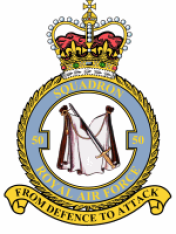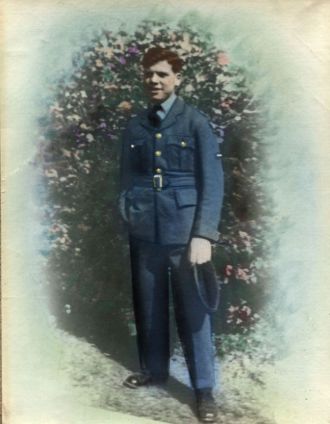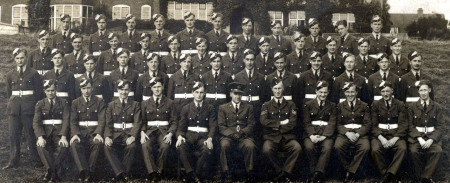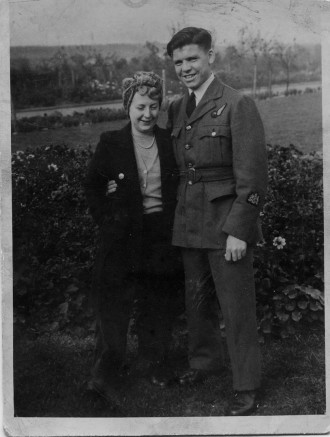Warrant Officer Norman Goodfellow
Norman volunteered to join the R.A.F as a 19 year old apprentice engineer in late 1942 when the war was already 3 years old and losses from all services were very high. He married in 1942 and by July 1943 was on his way to Canada (Rivers, Manitoba) on board the White Star liner Queen Mary under the Commonwealth Air Training Scheme, to become an air navigator.
Returning to the U.K in March 1944 he joined No.16 Operational Training Unit at R.A.F. Upper Heyford for familiarisation on heavy bomber navigation on Wellington aircraft followed by three months at 1654 Conversion Unit on Stirlings, followed by 2 weeks at No.5 Lancaster Finishing School, before being posted to No.50 Squadron at R.A.F. Skellingthorpe (Lincolnshire), part of No.5 Bomber Command, in August 1944. After 181 ¾ hours daylight flying and 132 hours night time he flew his first operational sortie against Brest on 5th September 1944 in Lancaster VN-M.
The crew consisted of; F/O J S Marris, Sgt R A Kingham, Sgt N Goodfellow, Sgt S R Collins, F/Sgt E heap, W.O. D Gapp, Sgt A A L Colston.
5th September 1944. Lancaster III LM628. Bombing attack on Brest (Daylight raid).
10th September 1944. Lancaster I LM162 Bombing attack on The port of Le Havre. Sgt H Hunter replaced W.O. Gapp on a permanent basis.
11th September 1944. Lancaster I LM296. Bombing attack on Damstadt in Southern Germany by 226 aircraft. It’s estimated that 12000 Germans died and 70,000 were bombed out. 12 aircraft failed to return.
12th September 1944. Lancaster LM629, VN-O (“Oboe”) Bombing attack on Stuttgart with over 11,000 killed and the longest trip so far (8 hours).
17th September 1944. Lancaster III LM629. Bombing attack on Boulogne by over 700 aircraft in a daylight raid when over 3000 tons of bombs were dropped. (The town was captured by allied forces one week later.
18th September 1944. Lancaster III LM629. Bombing attack on Bremerhaven destroying 2600 buildings. One Lancaster plus one Mosquito failed to return.
19th September 1944. Lancaster III LM629. Bombing attack on Rheydt. This was the night when Guy Gibson (Leader of the Dam buster Raid in May 1943) was killed in a Mosquito. 3 Lancaster also failed to return.
5th October 1944. Lancaster III LM629. Bombing attack on Willhelmshaven by 200 Lancasters.
6th October 1944. Lancaster III LM629. Bombing attack on Bremen.
7th October 1944. Lancaster III LM629. Bombing attack on Walcheren Island. This lies in the Scheldt estuary near Antwerp and the plan was to attack the huge sea walls to cut off the German retreat.
11th October 1944. Lancaster III LM629. Bombing attack on Flushing again to destroy German positions on the “Atlantic Wall”.
14th October 1944. Lancaster III LM629. Bombing attack on Brunswick.
19th October 1944. Lancaster III LM629 Bombing attack on Nurnberg. Both night raids of over 7 hours each. (P.O. L W Beer joined crew as second pilot).
23rd October 1944. Lancaster III LM629. Bombing attack on Flushing.
29th October 1944. Lancaster III LM629. Bombing attack on the U boat pens at Bergen (Norway). these were destroyed by 237 Lancasters. VN-O had to land at R.A.F. Pocklington on return due to fog at Skellingthorpe.
1st November 1944. Lancaster I LM296. Bombing attack on Homberg. The target was Meerbeck Oil Plant, attacked by 200 Lancasters. (On this trip Sgt N Goodfellow flew with Sqn Ldr Jimmy Flint and his crew).
16th November 1944. Lancaster III LM629. Bombing attack on Durën, at the request of the U.S.A. Durën was bombed in an attempt to cut enemy communications.
21st November 1944. Lancaster III LM629. Bombing attack on the Dortmund-Ems canal viaduct at Ladbergen, breached in two places by a precision bombing raid. 3 aircraft failed to return.
22nd November 1944. Lancaster Bombing attack on Trondheim. A round trip of over 10½ hours.
26th November 1944. Lancaster III LM629. Bombing attack on Munich by 600+ aircraft.
4th December 1944. Lancaster III LM629. saw an attack on Heilbronn (North of Stuttgart) when over 500 Lancasters bombed the Railway Marshalling yards resulting in 7,000 German deaths. 12 Lancasters failed to return.
6th December 1944. Lancaster III LM629. Bombing attack on Geissen (North of Frankfurt). Again the target was the railway yards.
8th December 1944. Lancaster III LM629. Bombing attack on the Urft Dam, Heinbach. Attack unsuccessfull and a return visit had to be made on the 11 December before the dam wall was breached.
11th December 1944. Lancaster III LM629. Bombing attack on Urft Dam, Heinbach.
17th December 1944. Lancaster I PB755. Bombing attack on Munich by 600 Lancasters (9½ hour trip).
1st January 1945. Lancaster I LM234. Bombing attack on the Dortmund-Ems canal at Ladbergen was revisited having been repaired since the previous raid in November 1944.
4th January 1945. Lancaster I SW253. Bombing attack on Royan in France at the request of free French forces who were finding heavy German resistance around the town.
5th January 1945. Lancaster I SW253. Bombing attack on Houffalize. A large German supply dept in the Belgium Ardennes.
7th January 1945. Lancaster I SW253. Bombing attack on Munich.
13th January 1945. Lancaster I SW253. Bombing attack on Politz. This was Normans last trip.
Of the aircraft that Norman flew in LM628 was lost on the night of 11th November 1944 on a raid to Gravenshorst. LM162 was lost on the night of 12th September 1944 on a raid to Stuttgart. LM296 survived the war. LM629 was lost on a raid to Munich with 57 Squadron. PB755 was lost on 25th June 1945 whilst testing enemy radar. LM234 was lost on the night of 14th january 1945 on a raid to Leuna. SW253 Survived.
As was usual in early 1945 after a “tour” of 30 operations most aircrew were retained as instructors. So Norman became a staff navigator at 1661 conversion unit until December 1945 when he was posted to Egypt awaiting transfer to the Far East where the war with Japan continued.
After the bombing of Hiroshima and Nagasaki and the Japanese surrender no further service personnel were required so he came back to the U.K. and was demobilised on 30th September 1946






